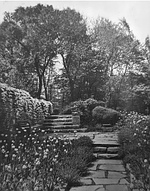Stories Behind the Stones – Gardens and Gardeners
Tucked away behind 15 Closter Road lies the Palisades Cemetery. In this bucolic setting, the stones not only mark the final resting place of more than 800 Palisades area residents, but also represent a remarkable record of our hamlet’s storied past and the diversity of its citizens.
Bankers and entrepreneurs are buried here, but so too are the servants and artisans, craftsmen and laborers employed by the wealthy landowners who populated the many estates that dotted the landscape in centuries past on the rugged cliffs overlooking the Hudson River. Here lie many of our hamlet’s earliest settlers, people who worked the land and sea, farmers, fishermen, tradesmen and patriots who defended our land and its citizens in every conflict since the Revolutionary War.
After opening the cemetery gate, you find on your left the oldest part of the cemetery containing the Old Lawrence Family Burying Ground and plots for some of Palisades’ most revered families: the Manns, the Martins, the Garrisons. Following the cemetery lane to the right, you see two large monuments for Winthrop Sargent Gilman (1839-1923) and Thomas Poynton Gilman (1840-1937), cousins from the wealthy banking family in New York City. The inscription on Winthrop Gilman’s memorial, I HAVE KEPT THE FAITH II:TIM. IV, VII, is from the biblical text in Timothy’s second letter, “I have fought the good fight, I have finished the race, I have kept the faith…”
And, indeed, he did.
Winthrop Gilman came to know and love the people of Palisades and left a lasting mark on the community. First as a summer visitor to Fern Lodge on Ludlow Lane, which his father had built in the year after the Civil War, and then as a resident, building a grand estate next door that he named Niederhurst. He designed and built it along with his cousin Tom. After his father built Heyhoe, a mansion on Rockland Road (now Route 9W), Fern Lodge became the home for his nephew, Thomas. The abundant flora and fauna on the Palisades cliffs attracted many to Palisades. When Thomas Gilman left the banking business for health reasons, he devoted his life to nature, especially birds and wildflowers. His niece, eminent horticulturalist and writer, Anna Gilman Hill, dedicated her book, Forty Years of Gardening to him:
To
THOMAS POYNTON GILMAN
“Cousin Tom”
who built the gardens at
niederhurst for my mother
and for me
(1840-1937)
Gilman’s father-in-law, Charles Frederick Park, a wholesale tea and coffee merchant, lived in Bloemendael (now the Upper Westside), a pastoral area north of the hustle and bustle of the lower part of Manhattan. As development began encroaching upon his neighborhood, Park recalled the beauty of the woods on the Palisades he explored in previous years with noted botanist Dr. John Torrey, and found farms available to the west of the cliffs. In clearing the land to build a summer home, seven white oaks were left on the hillside’s sloping lawn. Seven Oaks and Torrey Cliff ultimately became part of the 125 acres donated by Mrs. Thomas Lamont to Columbia University in 1948, now the Lamont-Doherty Earth Observatory.
An 1874 Map of Palisades shows at least nine named estates. Many of these had their own greenhouses and magnificent gardens. The Gilded Age in Palisades accommodated an influx of workers such as gardeners, nurserymen, and day laborers to help maintain these gardens.
Other tradesmen such as carpenters, slate roofers, stone masons, brick masons, and blacksmiths helped to build and preserve the grand homes. In addition to locals, many of the gardeners were from Ireland and the tradesmen from continental Europe.
Their final resting places are scattered among the stones throughout the Palisades Cemetery.
Surrounding the Gilman plot you can find many of these gardeners and growers: Brown, Pauli, Smith, Sneden, Kerner, Post, Jordan and others whose inclinations have given rise to the picturesque settings here in Palisades – as well as tradesmen like Van Valen, Adriance, Quidor, Parcells and Stansbury to name a few. With just a bit of imagination, one can see the “upstairs/downstairs” conversations between these former residents, making the cemetery itself seem to come alive with the hustle and bustle of a small rural hamlet embracing its scenic past while growing into a vibrant suburb in the shadow of the greatest city in the world.



